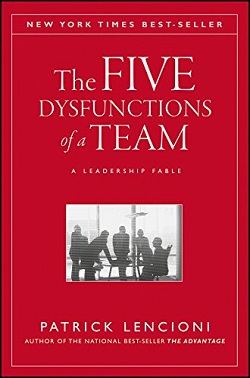The Five Dysfunctions Of A Team
by Patrick Lencioni

Summary: Management teams face a number of hurdles as they strive to achieve cohesion and become an effective leadership unit. In The Five Dysfunctions of a Team, Lencioni presents a model that accounts for why even a great group of leaders can struggle. In a nutshell: They lack trust, they fear conflict, they lack commitment, they avoid accountability, and they are inattentive to results.
But, Lencioni also describes why each dysfunction stands in the way of team success. For example, team members who don’t trust can’t be vulnerable in front of one another; teams that avoid conflict repeatedly revisit issues without resolution; teams that don’t commit to decisions create environments wherein small gaps devolve into major discrepancies; team members who do not assume accountability overlook performance or behaviors that hurt the team; and team members that do not focus on specific objectives or clearly defined outcomes indicate to others that results are not terribly important, thereby setting themselves up for failure.
Review: Patrick Lencioni is a popular face on the speaking circuit and a prolific author with nearly one dozen books to his name. He is known particularly for his counseling on team management, which is built around a fable that entertains even as it instructs. I read Five Dysfunctions 13 years ago, right after I earned an MBA and was still diligent about notetaking. I rediscovered my Five Dysfunctions notes as I cleaned out my desk this spring and discovered Lencioni’s advice still resonates today.
The movement has excellent leaders whole institutions as well as individual personalities but talk of coopetition hints at a lack of trust in an industry whose core strength should lie in uniting around a common good. There are differing opinions on what the future of the movement should look like. Committing to one that will set the movement apart from, and above, competitors will require unfiltered, passionate, and open debate. Lencioni provides the framework to help make that happen at an institutional as well as industrywide level.
Alix Patterson, Chief Experience Officer, Callahan & Associates
The Color of Money: Black Banks and the Racial Wealth Gap
by Mehrsa Baradaran

Summary: As an in-depth historical text akin to Howard Zinn’s A People’s History of the United States, Mehrsa Baradaran’s The Color of Money begins with slavery, as its practice is the basis upon which American wealth is built.
It is often said The American Dream, usually defined by prosperity or economic success, can only be achieved though sacrifice, risk-taking, and hard work. Poverty or economic stagnation is frequently blamed on the choices and behaviors of the individual this is especially true where race is concerned.
The Color of Money examines the intricacies of black America’s current economic situation by analyzing the politicians, activists, and economists who mistakenly believed that one idea black banking would be the simple solution to an impossibly complex situation.
When the U.S. government established the Freedmen’s Bank in 1865, if left out key aspects of capitalism namely, lending as a means of growing capital and let in speculative investment practices that resulted in the loss of nearly $3 million in deposits, bankrupting the institution and forcing it to shut its doors to hundreds of thousands of newly emancipated depositors.
In the nearly 150 years since, more black-owned banks have opened, yet the racial wealth gap today remains as wide as it was when slaves were emancipated in 1863.
Review: Baradaran argues that political policies supersede the potential effectiveness of black banking institutions. Bootstrap thinking simply isn’t enough to achieve The American Dream in the black community.
This position makes The Color of Money a must-read for those in the financial sector, especially for those institutions whose mission is to serve people of modest means or other segments of traditionally under- or unbanked populations. I recommend this book to credit union leaders, specifically, because they see firsthand the challenges presented by our nation’s economic history and complexities inherent in the creation of wealth. The roots of the credit union movement lie in overcoming these obstacles.
Phylicia Atkins, Client Experience Specialist, Callahan & Associates
This article appeared originally in Credit Union Strategy & Performance. Read More Today.